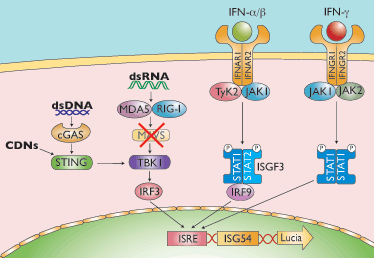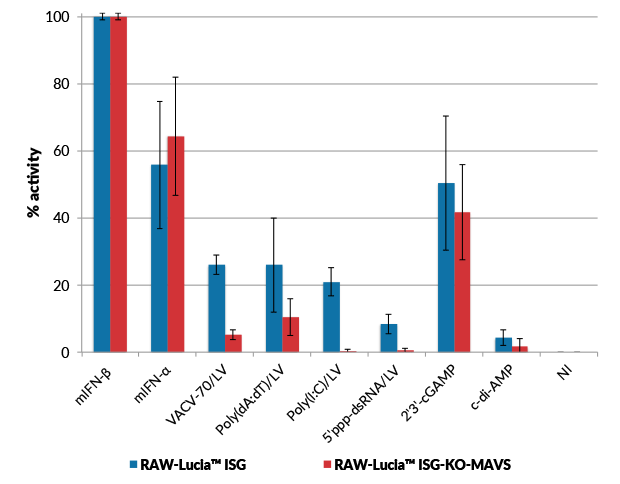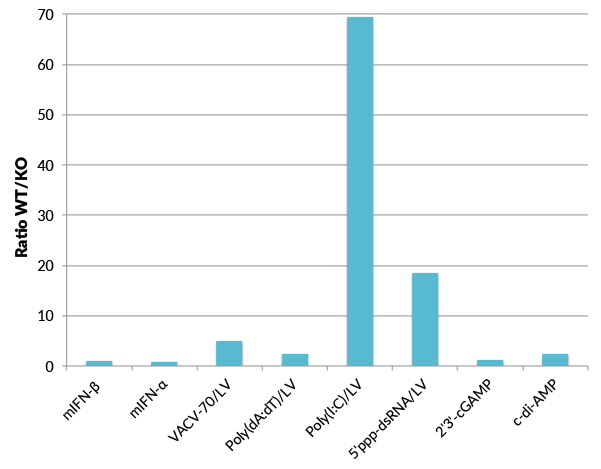RAW-Lucia™ ISG-KO-MAVS Cells
| Product | Unit size | Cat. code | Docs. | Qty. | Price | |
|---|---|---|---|---|---|---|
|
RAW-Lucia™ ISG-KO-MAVS Cells MAVS Knockout IRF-Lucia Luciferase Reporter Cells |
Show product |
3-7 x 10e6 cells |
rawl-komavs
|
|
||
|
RAW-Lucia™ ISG-KO-MAVS vial Additional cell vial |
Show product |
3-7 x 10e6 cells |
rawl-komavs-av
|
Notification: Reference #rawl-komavs-av can only be ordered together with reference #rawl-komavs.
MAVS Knockout IRF-Lucia Luciferase Reporter Cell Line
RAW-Lucia™ ISG-KO-MAVS cells were generated from RAW-Lucia™ ISG cells through the stable knockout of the MAVS gene. These cells derive from the murine RAW 264.7 macrophage cell line, which has been reported to express many pattern recognition receptors (PRRs), including the dsRNA sensors MDA-5 [1] and RIG-I [2, 3] along with their adaptor protein MAVS [3].
RAW-Lucia™ ISG-KO-MAVS and RAW-Lucia™ ISG cells can be used to study the role of MAVS by monitoring of IRF-induced Lucia luciferase activity. They express the gene for secreted Lucia luciferase under the control of an IFN-inducible IFN-stimulated genes 54 (ISG54) promoter enhanced by a multimeric IFN-stimulated response elements (ISRE). The levels of IRF-induced Lucia in the cell culture supernatant can be easily monitored using QUANTI-Luc™ 4 Lucia/Gaussia, a Lucia and Gaussia luciferase detection reagent.
RAW-Lucia™ ISG-KO-MAVS cells are resistant to Zeocin®.
References:
1. Hasan M. et al., 2011. Antimicrobial peptides inhibit polyinosinic-polycytidylic acid-induced immune responses. J Immunol. 187(11):5653-9.
2. Melchjorsen J. et al., 2005.Activation of innate defense against a paramyxovirus is mediated by RIG-I and TLR7 and TLR8 in a cell-type-specific manner. J Virol. 79:12944-51.
3. Yamashita M. et al., 2013. Antiviral innate immunity disturbs podocyte cell function. J Innate Immun. 5:231-41.
Specifications
Antibiotic resistance: Zeocin®
Growth Medium: DMEM, 4.5 g/l glucose, 2 mM L-glutamine, 10% (v/v) heat-inactivated fetal bovine serum, 100 U/ml penicillin, 100 μg/ml streptomycin, 100 μg/ml Normocin™ supplemented with Zeocin®
Quality Control:
MAVS knockout has been verified by functional assays (see validation sheet) and DNA sequencing.
The stability of this cell line for 20 passages following thawing has been verified.
The cells are guaranteed mycoplasma-free.
Back to the topContents
- 1 vial containing 3-7 x 106 cells
- 1 ml of Zeocin® (100 mg/ml)
- 1 ml of Normocin™ (50 mg/ml)
- 1 tube of QUANTI-Luc™ 4 Reagent, a Lucia luciferase detection reagent (sufficient to prepare 25 ml)
![]() Shipped on dry ice (Europe, USA, Canada and some areas in Asia)
Shipped on dry ice (Europe, USA, Canada and some areas in Asia)
Description

Mitochondrial antiviral-signaling protein (MAVS; also known as IPS1, CARDIF, VISA) is an adaptor protein that plays a critical role in the immune response to viral infection. The innate immune system senses intracellular double-stranded RNA (dsRNA), a replication intermediate for RNA viruses, through two RNA helicases: retinoic acid inducible gene-I (RIG-I) and melanoma differentiation-association gene 5 (MDA5). These two sensors recognize different ligands, yet both signal through MAVS. Specifically, upon recognition of dsRNA, they are recruited by MAVS to the outer membrane of the mitochondria leading to the activation of interferon regulatory factor 3 (IRF3), which in turn regulates the expression of type I interferons (IFNs).
Back to the top







